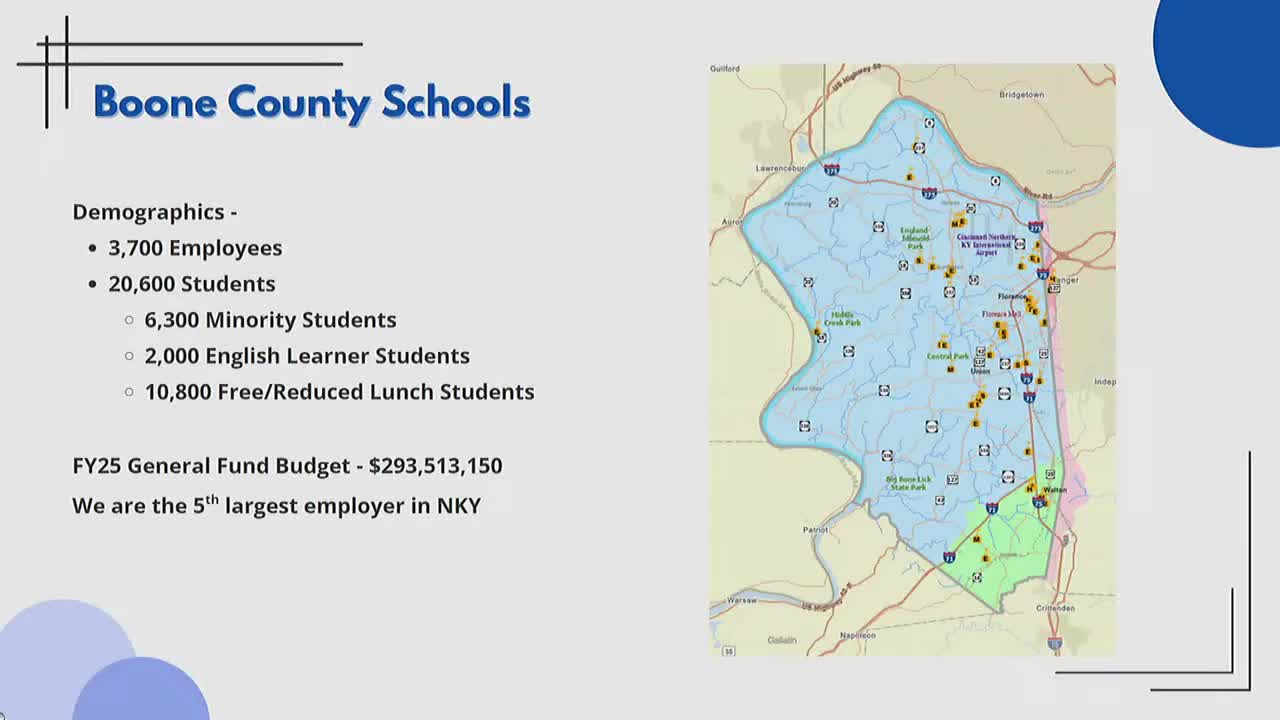Boone County Schools spearheads unified curriculum to support underserved students
May 09, 2025 | Boone County, School Boards, Kentucky
This article was created by AI summarizing key points discussed. AI makes mistakes, so for full details and context, please refer to the video of the full meeting. Please report any errors so we can fix them. Report an error »

The Boone County School Board meeting on May 9, 2025, highlighted significant advancements in educational strategies and resources aimed at improving student outcomes. With a student population of 20,600 and 3,700 employees, the district is focusing on enhancing educational equity and performance, particularly for its priority populations, which include 6,300 students of color and 2,000 English learners.
One of the key discussions centered around the district's impressive academic achievements. The graduation rate stands at 96%, and Boone County Schools is recognized as the only district in Kentucky to have closed the learning loss gap caused by the COVID-19 pandemic, according to a recent Harvard University report. This accomplishment places Boone County among the top ten school districts in the United States for academic recovery since 2019.
The meeting also introduced the district's strategic plan, which encompasses four main pillars: world-class education, an empowered workforce, stakeholder engagement, and operational resource optimization. A significant focus is on creating a unified curriculum to ensure consistency across schools, particularly for students who frequently move between different educational environments. This initiative aims to minimize disruptions in learning and improve educational outcomes for students from low-income backgrounds.
Additionally, the board discussed the implementation of new K-12 diagnostic assessments to standardize evaluations across the district. This move is expected to enhance data comparability and efficiency while reducing costs. The district is also pioneering the adoption of multi-language communication tools, making it the first in Kentucky to provide real-time translation services for all students, thereby supporting English learners more effectively.
Overall, the Boone County School Board is committed to fostering an inclusive and high-quality educational experience for all students, with plans to accelerate these initiatives in the coming years. The board's focus on systemic changes and resource optimization reflects a proactive approach to addressing the diverse needs of its student population.
One of the key discussions centered around the district's impressive academic achievements. The graduation rate stands at 96%, and Boone County Schools is recognized as the only district in Kentucky to have closed the learning loss gap caused by the COVID-19 pandemic, according to a recent Harvard University report. This accomplishment places Boone County among the top ten school districts in the United States for academic recovery since 2019.
The meeting also introduced the district's strategic plan, which encompasses four main pillars: world-class education, an empowered workforce, stakeholder engagement, and operational resource optimization. A significant focus is on creating a unified curriculum to ensure consistency across schools, particularly for students who frequently move between different educational environments. This initiative aims to minimize disruptions in learning and improve educational outcomes for students from low-income backgrounds.
Additionally, the board discussed the implementation of new K-12 diagnostic assessments to standardize evaluations across the district. This move is expected to enhance data comparability and efficiency while reducing costs. The district is also pioneering the adoption of multi-language communication tools, making it the first in Kentucky to provide real-time translation services for all students, thereby supporting English learners more effectively.
Overall, the Boone County School Board is committed to fostering an inclusive and high-quality educational experience for all students, with plans to accelerate these initiatives in the coming years. The board's focus on systemic changes and resource optimization reflects a proactive approach to addressing the diverse needs of its student population.
View full meeting
This article is based on a recent meeting—watch the full video and explore the complete transcript for deeper insights into the discussion.
View full meeting
